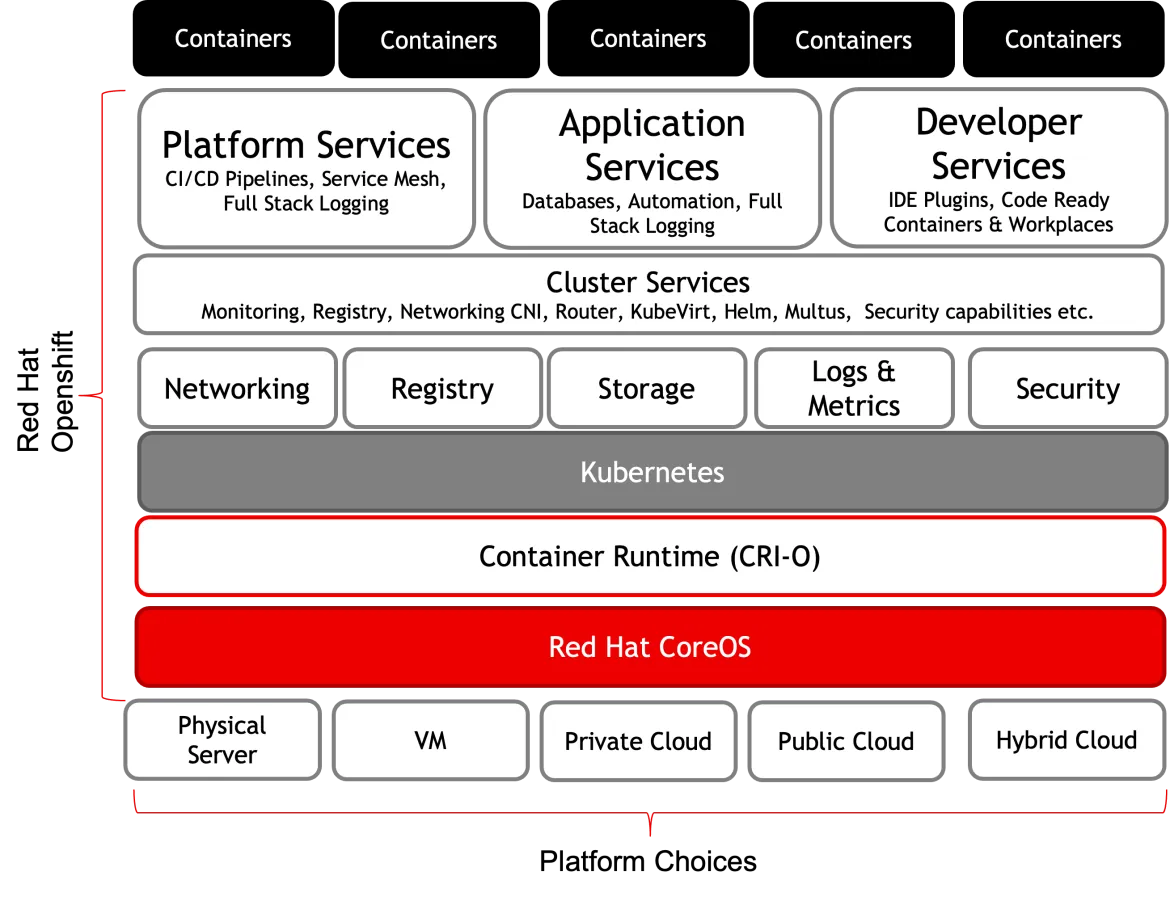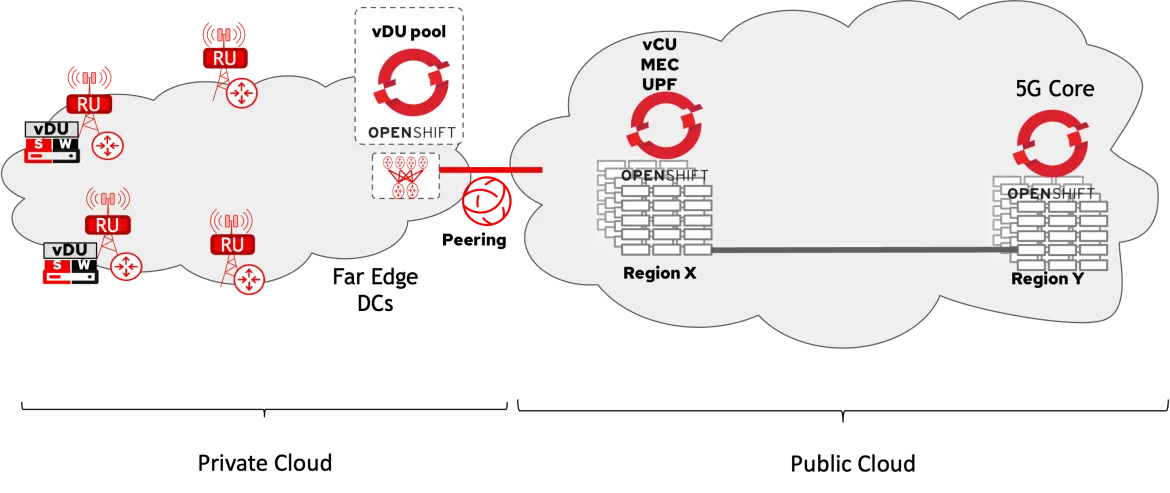Red Hat is not a mobile network equipment vendor. It does not provide the antenna, Radio Unit (RU), baseband unit (BBU), or any of its decomposed components—the Distributed Unit (DU) and Central Unit (CU). It does not have any mobile core functions in its portfolio, either. So really, what does Red Hat OpenShift have to do with Cloud RAN?
Read other articles in this series:
- The road to Cloud RAN from 1G to 5G
- 20 radio access network (RAN) terms to know
- What is Open RAN?
- Comparing Red Hat OpenShift models for Cloud RAN deployments
The answer lies in the virtualization and cloudification of mobile functions and infrastructure over the past decade.
Red Hat has been the leading provider of open source tools and platforms for enterprises and service providers over the past several decades. Red Hat has also been the foremost contributor to various open source upstream projects, including Kubernetes, which has become the de-facto standard for container orchestration.
With a shift towards microservices and the cloud-native nature of virtualized RAN (as well as the mobile core), there is a need for a common horizontal cloud platform that can span the entire mobile network, including the cell site, far edge datacenters, edge datacenters, and regional or national datacenters. This cloud platform must also fulfill the unique and specific needs of orchestrating, managing, and monitoring the cloud-native RAN functions (that is, the vDU and vCU) and the 5G Core functions such as the Access and Mobility Management Function (AMF), user plane function (UPF), session management function (SMF), and the policy control function (PCF). This is where Red Hat OpenShift Container Platform comes into the picture.
[ See the deploying telco 5G in public cloud and on-premises environments portfolio architectures for more about these functions. ]
OpenShift meets all of the above-mentioned requirements for a horizontal cloud platform. The following figure shows an overview of OpenShift, which fulfills this role across the entire mobile communication network:

How OpenShift enhances Kubernetes
Kubernetes started as an internal project by Google to tackle the challenge of orchestrating and managing a large number of containers. Later, it was made open source and available to the community.
Red Hat has been the leading contributor to the open source Kubernetes project. While Kubernetes is a community-maintained project, Red Hat has taken it a step further with OpenShift—a Kubernetes product built to be robust, scalable, and highly resilient. It offers a service provider-grade Kubernetes distribution and is backed by Red Hat's decades of expertise. OpenShift is Kubernetes, but with additional capabilities and features required by a production-grade service provider cloud platform.
[ Learn more about how OpenShift and Kubernetes compare. ]
The following figure gives a high-level overview of how OpenShift enhances Kubernetes.

Here are just a few of the key differentiators that make OpenShift the leading Kubernetes distribution:
Fully integrated and tested: As a community-maintained tool, Kubernetes is flexible, and while it defines the interface for networking, storage, and more, it doesn't dictate the use of any particular plugin for them. That's a perfect approach for a community project but not suited for a service provider-grade orchestrator. Service providers require a well-integrated and well-tested environment backed by dedicated support. OpenShift offers that through the use of the Operator framework.
GUI-based management: Command-line interfaces and application programming interfaces (APIs) are essential for automating and scripting tasks, but they are not a substitute for the graphical interfaces that offer quick visual monitoring and management mechanisms. Most API-based monitoring tools present their findings using a visual dashboard. While Kubernetes doesn't have a built-in management interface, OpenShift provides an intuitive and easy-to-use graphical interface that fills that void.
DevOps support: Support for DevOps tools comes out of the box with OpenShift. This support makes it possible to follow the continuous integration/continuous deployment (CI/CD) development model widely used to achieve faster time to market.
Security: Kubernetes on its own doesn't have robust security features built into it. The foundations are laid out using features such as roles and rolebindings, but it falls short of what a commercial-grade orchestrator requires. OpenShift fills this gap and allows options to augment the cloud platform with features that provide a well-secured environment. You can find some details about security on the Red Hat Advanced Cluster Security for Kubernetes site.
Multi-cluster management: Kubernetes doesn't include a cluster-management application. Open source tools can be used for this purpose, but they often fall short and do not offer the full set of capabilities and interfaces that cluster management requires. Red Hat provides a scalable and powerful cluster management tool through Advanced Cluster Management (ACM).
You can find more details about what OpenShift offers at the following links:
- Red Hat's OpenShift vs. Kubernetes page
- IBM's OpenShift vs. Kubernetes: What's the difference?
- Red Hat OpenShift features and benefits
Hybrid cloud and mobile network deployments
Hyperscalers, including AWS, Azure, and GCP, are good options for enterprises to move their applications into the public cloud, as they reduce capital expenditure, shorten time to market, and offload their IT infrastructure.
[ How to use cloud hyperscalers to handle 5G traffic demand bursts. ]
Some mobile service providers are also starting to adopt the public cloud for similar benefits. The move towards virtualization and cloudification of mobile functions in both RAN and packet core has already made many of those functions a good fit for the public cloud. Although some containerized functions (such as vDU, due to its latency limitations) are not well suited for public cloud, many of the functions can be placed on public cloud.
Nevertheless, mobile providers implementing 5G have been considering or, in some cases, already implementing part of the mobile network using public cloud. One of the first examples of utilizing the public cloud to deploy mobile networks is Dish Networks, with its 5G Core and part of its RAN (vCU, specifically) hosted in public cloud. However, even Dish Networks hosts the vDUs using an on-premises private cloud, making it one of the first examples of a hybrid cloud approach to implementing a mobile network. Others are considering similar methods with some variations. The image below shows how OpenShift can be used as the horizontal cloud platform in both private and public cloud infrastructure

Deployment with cloud-native or containerized mobile functions over hybrid cloud environments also requires the horizontal cloud platforms to stretch between the public and private cloud while still providing a common, seamless, and efficient way to orchestrate, manage, and monitor the entire mobile ecosystem. Red Hat enables this and provides various flavors of OpenShift for on-premises, public, or private cloud deployments. This results in a consistent and uniform end-to-end user experience spanning a hybrid cloud environment for the mobile network.
OpenShift offers the following deployment options to fit hybrid cloud deployment scenarios for telco needs:
- Red Hat OpenShift Container Platform provides an OpenShift deployment on a private cloud running over bare metal servers or virtual machines, which affords the service provider maximum flexibility and comprehensive control of its infrastructure.
- Azure Red Hat OpenShift (ARO) offers a full OpenShift cluster on demand running over Microsoft's Azure public cloud. The ARO platform is jointly engineered and managed by Red Hat and Microsoft.
- Red OpenShift Service on AWS (ROSA) is a managed Red Hat OpenShift service running natively over Amazon's AWS public cloud.
- Red Hat OpenShift on IBM Cloud provides a managed OpenShift deployment over IBM Cloud.
- Red Hat OpenShift Dedicated is a Red Hat-managed OpenShift deployment that can be hosted on AWS or GCP.
[ Try this learning path: Getting started with Red Hat OpenShift Service on AWS (ROSA) ]
Wrapping up
To summarize, the Red Hat OpenShift Container Platform provides a tested, proven, and reliable horizontal cloud platform enabling the next generation of cloud-native mobile networks. The next article in this series will explore the various form factors of OpenShift deployments and considerations for placing them at different locations in a mobile network.
This article is adapted from So what does Red Hat have to do with Cloud RAN and is republished with permission.
저자 소개
Kashif Islam is a Principal Telecommunication Architect in Red Hat's consulting organization. He helps service providers transform their existing mobile infrastructure into next-generation cloud-native 5G networks.
Kashif is a 20+ year veteran in the IT industry and has architected several complex, large-scale networks for some of the biggest wireline and mobile service providers across the world. He is also an O-RAN alliance contributor and co-authored O-RAN xHaul Packet Switched Architectures and Solutions specification. Kashif has also co-authored a book titled "A Network Architect' Guide to 5G" which is the first book to cover mobile core, RAN, and transport technology fundamentals and network design details.
Kashif is a Certified Kubernetes Administrator (CKA) and a double CCIE (#14300) in Data Centers and Routing/Switching technologies. He holds a Bachelor's degree from Sir Syed University (Pakistan) and a Master of Engineering in Internetworking degree from Dalhousie University, Canada.
Syed F. Hassan is a Principal Telecommunications Architect at Red Hat, providing consultancy services to 5G service providers globally. In his 20+ year of experience, he has provided guidance, strategy, and planning support to various Internet, Cloud, and Mobile service providers in their adoption of innovative networking technologies and transformation of their networks to new architectures.
Syed has co-authored multiple books on leading technologies. He is the co-author of the first book on NFV and SDN, as well as the first book for 5G Network Architects ("A Network Architect's Guide to 5G"). He has been a regular speaker in public forums and conferences. Syed is a double CCIE in Service Provider and Data Center technologies (#21617), Google Certified Professional Cloud Networking Engineer, Certified Kubernetes Administrator (CKA), and a Red Hat Certified Specialist in Containers, Kubernetes and OpenShift Administration. He holds a bachelor's degree in engineering from NED University (Pakistan) and a master's degree in engineering from the University of Florida.
채널별 검색
오토메이션
기술, 팀, 인프라를 위한 IT 자동화 최신 동향
인공지능
고객이 어디서나 AI 워크로드를 실행할 수 있도록 지원하는 플랫폼 업데이트
오픈 하이브리드 클라우드
하이브리드 클라우드로 더욱 유연한 미래를 구축하는 방법을 알아보세요
보안
환경과 기술 전반에 걸쳐 리스크를 감소하는 방법에 대한 최신 정보
엣지 컴퓨팅
엣지에서의 운영을 단순화하는 플랫폼 업데이트
인프라
세계적으로 인정받은 기업용 Linux 플랫폼에 대한 최신 정보
애플리케이션
복잡한 애플리케이션에 대한 솔루션 더 보기
가상화
온프레미스와 클라우드 환경에서 워크로드를 유연하게 운영하기 위한 엔터프라이즈 가상화의 미래
